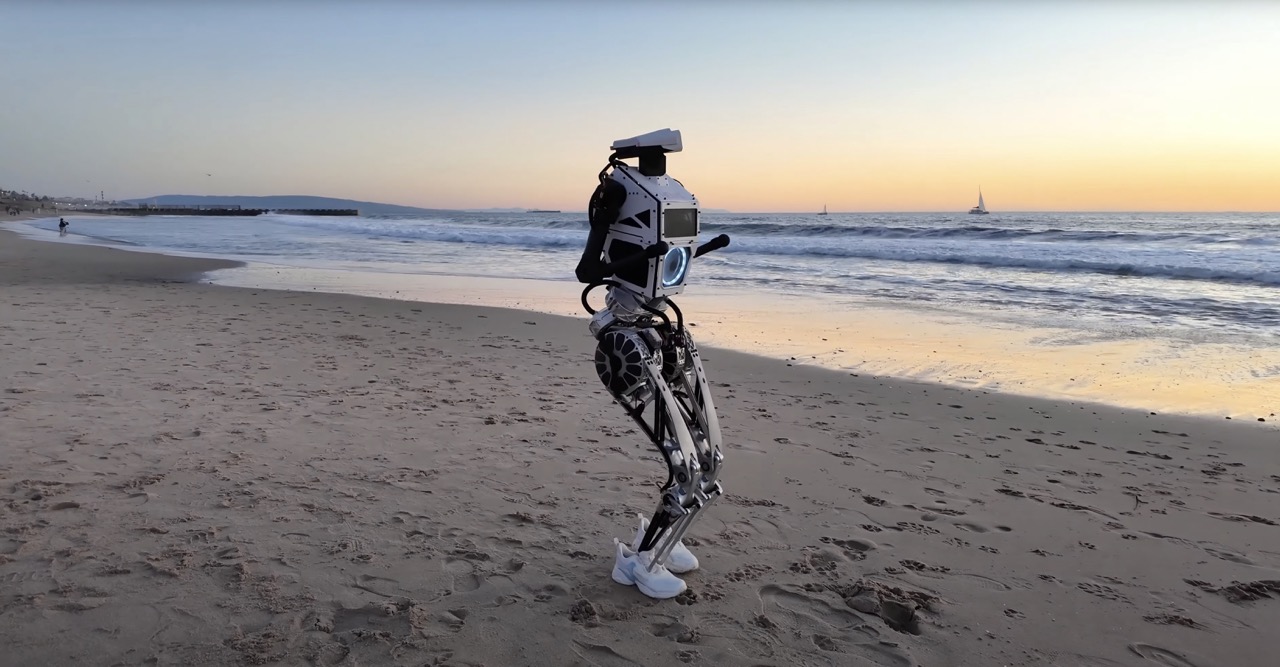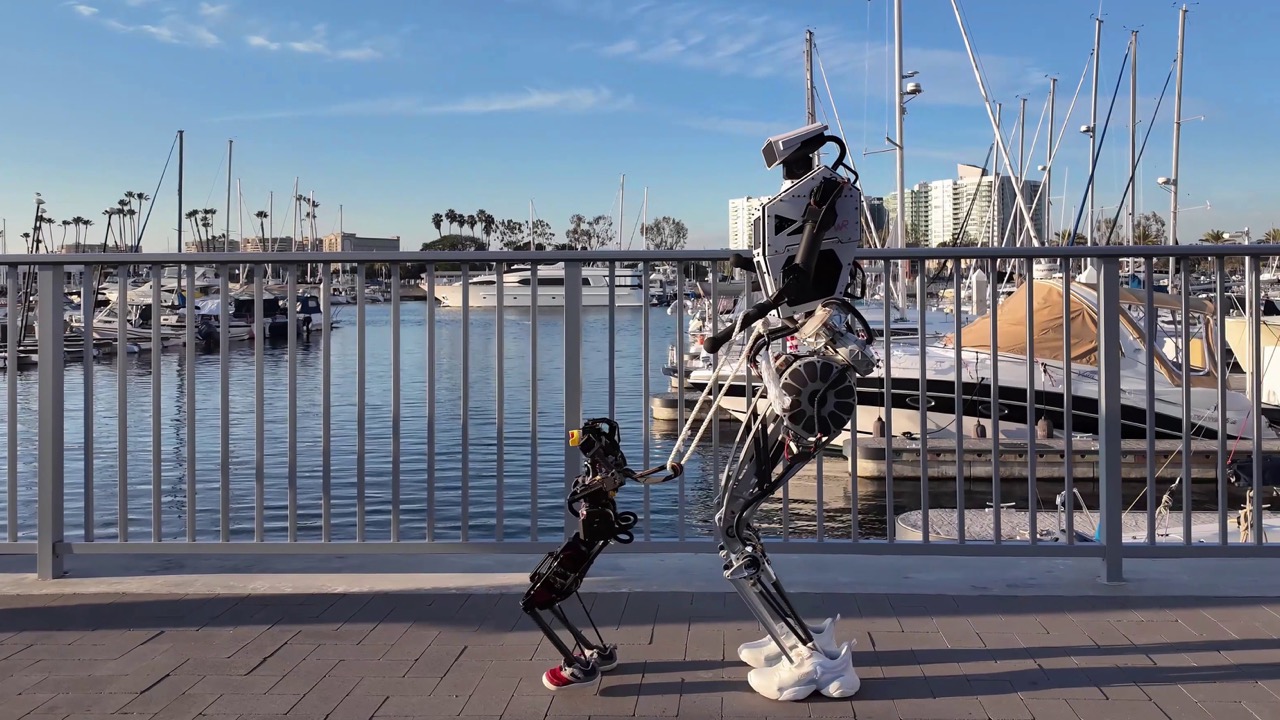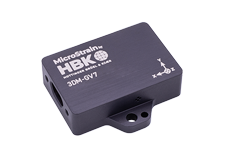Westwood Robotics was established in 2018 by a team of passionate roboticists from the Robotics & Mechanisms Laboratory (RoMeLa) at UCLA, boasting years of experience in developing advanced proprioceptive actuators and cutting-edge dynamic robotic systems.
Challenge
Creating humanoid robots involves complex integration of mechanical engineering, electronics, computer science, and artificial intelligence. Westwood Robotics' THEMIS, designed for agility, faced the challenge of maintaining equilibrium during dynamic activities like walking and running.
Solution
MicroStrain's 3DM-CV7-AHRS (attitude and heading reference system) inertial sensor was integrated into THEMIS to provide information about the robot's orientation (roll, pitch, and yaw) and its acceleration.
Result
The 3DM-CV7-AHRS sensor enhances THEMIS's development and experimentation, providing unparalleled accuracy and responsiveness for navigating intricate movements and quickly responding to environmental changes.
A Versatile Portfolio Shaping the Future of Humanoid Robots

In our rapidly evolving world, where robotics and automated processes play an ever-expanding role – whether in manufacturing, our homes, or delivery platforms – the demand for cost-effective, highly accurate, and reliable performance is paramount. Westwood Robotics offers cutting-edge robotic solutions for leading robotics research institutions and industrial partners in manufacturing, medical, and food industries. Their diverse portfolio includes the BEAR (Back-drivable Electromechanical Actuator for Robotics) series of actuators; BRUCE (Bipedal Robot Unit with Compliance Enhanced), the world’s only child-sized humanoid robot open platform, and THEMIS, the company’s latest, cutting edge, full-size humanoid robot. With powerful BEAR actuators and advanced sensing, THEMIS is designed for agility and safety, walking steadily at human speed, and reaching a top running speed of 10 km/h.
The Many Challenges of Humanoid Robots
Designing humanoid robots demands a multidisciplinary approach, merging expertise in mechanical engineering, electronics, computer science, and artificial intelligence. These challenges range from maintaining balance during dynamic movements like walking or handling; optimising power consumption for extended operation; crafting a flexible yet structurally sound mechanical design; implementing advanced sensor systems for perceiving diverse environments, and developing sophisticated control algorithms to coordinate numerous joints. Additionally, human-robot interaction poses challenges related to interpreting gestures, and avoiding collisions.
3DM-CV7 Helping to Maintain Balance and Stability

Westwood Robotics’ THEMIS was designed and optimised for safe interaction with the environment and for dynamic motions such as walking, running and even parkour manoeuvres. It embodies the company’s vision of integrating versatile humanoid robots into the world to perform general-purpose tasks with human-like finesse. In order to enable these sophisticated capabilities in autonomous devices and robotic instruments, sensors are seamlessly integrated with the unique shared memory structure on THEMIS to ensure the required reliability and precision, while remaining compatible with Robot Operating System (ROS) for extended functionalities.

MicroStrain’s 3DM-CV7-AHRS, a compact and lightweight Inertial Measurement Unit (IMU) and Attitude Heading Reference System (AHRS), plays a pivotal role in supplying crucial data regarding THEMIS’ orientation (roll, pitch, and yaw) and acceleration. Through the integration of sophisticated algorithms, this sensor data is fused to provide a significantly enhanced and stable estimation of the robot’s present condition. The IMU establishes direct communication with the robot’s control system, and this information serves multiple functions such as stabilising the robot, fine-tuning its orientation, and enabling precise navigation. The three main reasons behind selecting the 3DM-CV7 were:
- Accuracy and precision: the delivery of precise robot orientation measurements, essential for tasks requiring exact positioning or navigation
- Compact design: its light weight and compact design for easy integration across Westwood Robotics’ diverse robotic platforms without compromising weight constraints
- Ease of integration: the inclusion of built-in software libraries and APIs, streamlining integration into various control systems, thereby saving both time and resources during the development process.
Xiaoguang Zhang, Founder and CEO of Westwood Robotics says, “We experience seamless precision with the 3DM-CV7-AHRS sensor on the THEMIS humanoid robot. Configuring this IMU (Inertial Measurement Unit) is a breeze, ensuring a user-friendly setup process. What sets it apart is its ability to deliver reliable data at an impressive speed of 1 kHz, a crucial factor for real-time applications. Whether navigating intricate movements or responding swiftly to changes in the environment, the 3DM-CV7-AHRS sensor elevates our experience in development and experiments with THEMIS, providing unparalleled accuracy and responsiveness in every interaction.”
Westwood Robotics Technology and the Future of Humanoid Robots
The technological advancements showcased in BRUCE and THEMIS represent a significant leap forward in the evolution of humanoid robots, impacting their future in several key ways. By integrating advanced features such as high dynamic performance and reliable sensors like the 3DM-CV7-AHRS, alongside open-platform accessibility, these robots stand at the forefront of robotics research and development. THEMIS’ adaptability, coupled with its humanoid design and ability to execute tasks with human-like precision, unlocks potential applications across diverse industries – from navigating complex environments to enhancing human-robot collaboration. The inclusion of the 3DM-CV7-AHRS sensor further contributes to THEMIS’ responsiveness in real-time scenarios, making it well-suited for dynamic interaction and precise movement.

Meanwhile, BRUCE, with its focus on being a child-sized humanoid robot with an open platform, not only caters to researchers but also promotes a collaborative global community through the BRUCE Open-Source Project. This initiative is likely to foster innovation, accelerate research, and facilitate knowledge exchange among developers worldwide. In essence, the technology embodied in BRUCE and THEMIS, including MicroStrain sensors, is poised to influence the future of humanoid robots by pushing the boundaries of performance, accessibility, and collaborative research. These advancements have the potential to shape the landscape of robotics, making it more adaptable, versatile, and impactful across various domains.











